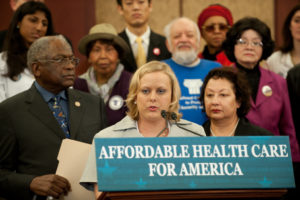 In early October, health plans around the country received the news: The government anticipated an estimated shortfall in excess of $2.4 billion in the risk corridor program that was intended to subsidize losses for care for expensive new patients brought in by the Affordable Care Act (ACA).
In early October, health plans around the country received the news: The government anticipated an estimated shortfall in excess of $2.4 billion in the risk corridor program that was intended to subsidize losses for care for expensive new patients brought in by the Affordable Care Act (ACA).
In the wake of an 87% shortfall from the promised subsidies, 11 health cooperatives around the country have folded or announced plans to close, according to an article in The Wall Street Journal. Others are threatening to follow suit.
The shortfall is a blow particularly to health cooperatives and smaller health plans around the country, which were depending on the risk-sharing initiative for protection against losses on the subsidized insurance exchanges. The problem facing health plans that certified to participate in the insurance exchanges was that they would be issuing coverage to patients with guaranteed issue irrespective of preexisting conditions, without using past medical history to underwrite limits. The influx of millions of previously uninsured patients, many with untreated conditions, threatened to present new, unknown claims patterns.
The risk corridors would enable plans to hold prices down to ensure affordability for the newly insured, and take on risk gradually. For three years (2014 to 2016), highly profitable plans would pay in and subsidize plans that lost money and needed support. The calculation measured various plans by comparing the premiums collected against each plan’s allowable costs (claims and other costs) against the insurer’s “target amount”—its premiums minus administrative expenses, including profit.
Plans that roughly broke even or had a profit or loss margin within 3% (i.e., a 97% to 103% ratio) would keep their profits or be responsible for their losses. The “winners” with a profit margin above 3% would pay the government from their profits. The “losing” plans with losses greater than 3% would benefit from the pool of reimbursement from the profitable plans. Health plans that had costs between 103% to 108% of the premiums they collected would receive 50% reimbursement of their losses. Plans with costs over 108% would receive 80% subsidization of their losses.
While this sounded like a promising model to stabilize the insurance market, it turns out that, for the first year of the program, profitable plans owed only $362 million, far short of the $2.87 billion requested from plans that lost money.
The problem is that the government is not permitted to rescue the program, which was supposed to remain revenue neutral, by covering the shortfall.
As a consequence, health plans that were depending on these subsidies are in financial trouble. The health corridors are not viable on a budget-neutral basis, but are locked into a decision that they would need to be self-financing.
While the majority of insurers were sufficiently profitable to have to pay money into the risk corridor program, their profit-sharing has been only a small fraction of the size of the losses from the minority of health plans that lost money. The administration now finds itself prevented by strong political opposition from covering the gap with alternative funding.
If the initial announcements are a representative indication, the primary victims of the program’s failure will be the health cooperatives and government plans, which had budgeted for the subsidies and now find themselves in a deep financial hole.
By contrast, the larger health plans did not expect or depend on money being returned to them, and in some cases may have omitted it from their accounting, a decision that now appears prescient. In this respect, recent events follow a pattern of previous managed care misadventures, in which inaccurate financial projections impose a disproportionate financial strain on smaller players, which lacked both the actuarial support to make good decisions and the financial reserves and liquidity to survive the unexpected.
By the time the federal government makes a decision about whether or not to finance the shortfall, it likely will be too late for many cooperatives that will have already closed their doors, narrowing of the ranks of insurers.
For more information/questions regarding any legal matters, please email [email protected] or call .
This article was originally published in Managed Healthcare Executive on November 10th, 2015.